ECU MITSUBISHI MIRAGE G4 2018 (in English) Owner's Guide
[x] Cancel search | Manufacturer: MITSUBISHI, Model Year: 2018, Model line: MIRAGE G4, Model: MITSUBISHI MIRAGE G4 2018Pages: 263, PDF Size: 37.9 MB
Page 84 of 263
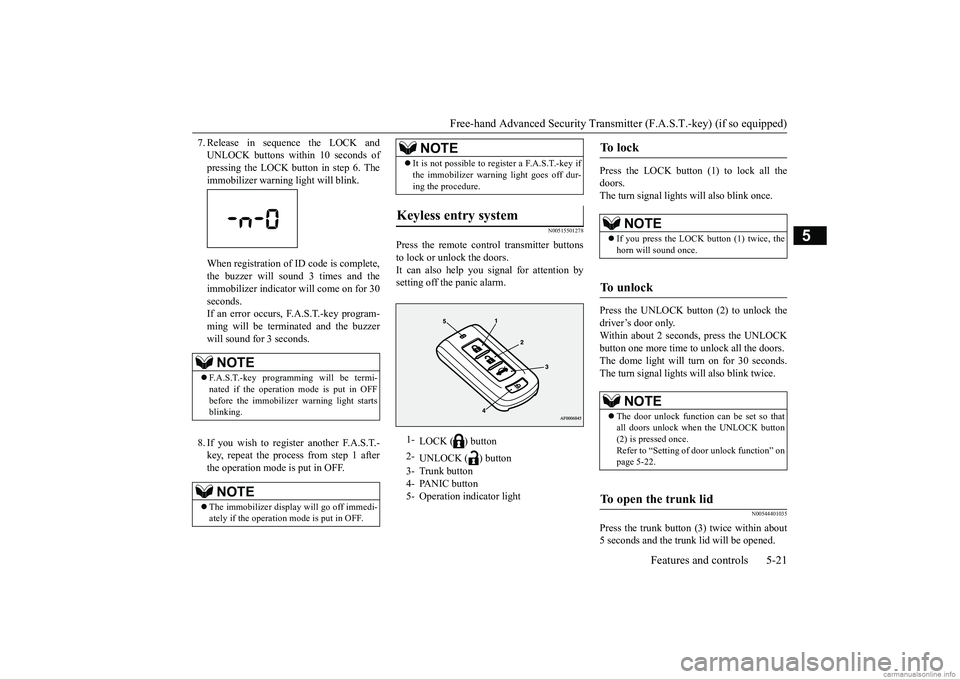
Free-hand Advanced Securi
ty Transmitter (F.A.S.T.-key) (if so equipped)
Features and controls 5-21
5
7. Release in sequence the LOCK and UNLOCK buttons within 10 seconds ofpressing the LOCK button in step 6. The immobilizer warni
ng light will blink.
When registration of ID code is complete, the buzzer will s
ound 3 times and the
immobilizer indicator will come on for 30 seconds. If an error occurs, F.A.S.T.-key program-ming will be terminated and the buzzer will sound for 3 seconds. 8. If you wish to register another F.A.S.T.- key, repeat the proc
ess from step 1 after
the operation mode is put in OFF.
N00515501278
Press the remote control transmitter buttons to lock or unlock the doors. It can also help you signal for attention by setting off the panic alarm.
Press the LOCK button (1) to lock all the doors. The turn signal lights
will also blink once.
Press the UNLOCK button (2) to unlock the driver’s door only. Within about 2 seconds, press the UNLOCKbutton one more time to
unlock all the doors.
The dome light will turn on for 30 seconds. The turn signal lights will also blink twice.
N00544401035
Press the trunk button (3) twice within about5 seconds and the trunk
lid will be opened.
NOTE
F.A.S.T.-key programming will be termi- nated if the operation mode is put in OFF before the immobilizer warning light starts blinking.NOTE
The immobilizer displa
y will go off immedi-
ately if the operation mode is put in OFF.
It is not possible to register a F.A.S.T.-key if the immobilizer warning light goes off dur-ing the procedure.
Keyless entry system
1-
LOCK ( ) button
2-
UNLOCK ( ) button
3- Trunk button 4- PANIC button 5- Operation indicator light
NOTE
To l o c k
NOTE
If you press the LOCK button (1) twice, the horn will sound once.
To u n l o c k
NOTE
The door unlock function can be set so that all doors unlock when the UNLOCK button (2) is pressed once.Refer to “Setting of
door unlock function” on
page 5-22.
To open the trunk lid
BK0249600US.book 21 ページ 2017年4月20日 木曜日 午後1時36分
Page 85 of 263
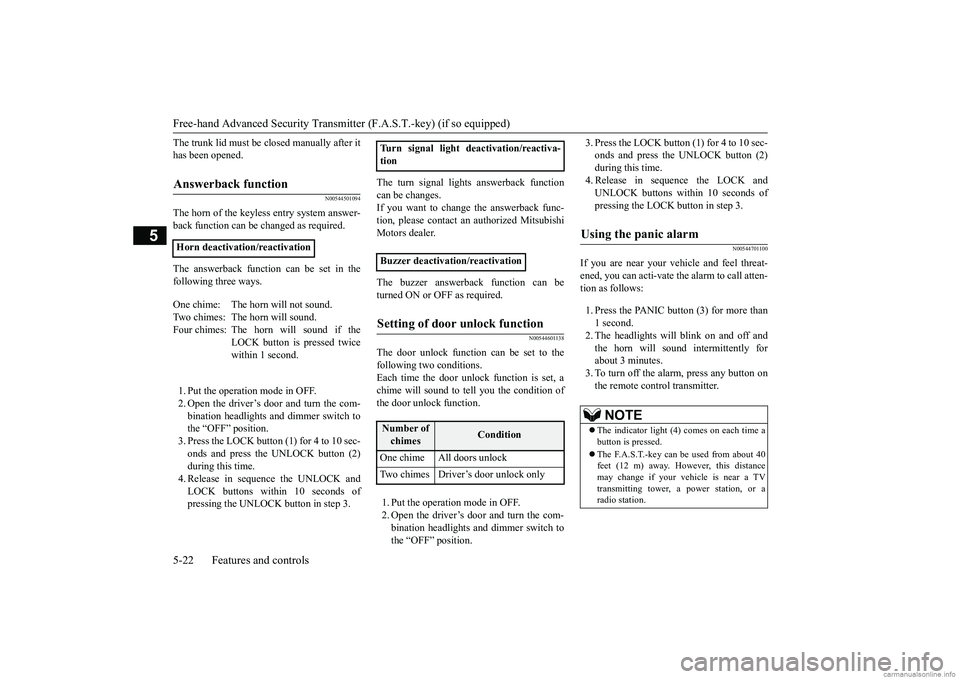
Free-hand Advanced
Security Transmitter (F.A.S
.T.-key) (if so equipped)
5-22 Features and controls
5
The trunk lid must be cl
osed manually after it
has been opened.
N00544501094
The horn of the keyless entry system answer-back function can be changed as required. The answerback function can be set in the following three ways. 1. Put the operation mode in OFF. 2. Open the driver’s door and turn the com- bination headlights and dimmer switch to the “OFF” position.3. Press the LOCK button (1) for 4 to 10 sec- onds and press the UNLOCK button (2) during this time.4. Release in sequence the UNLOCK and LOCK buttons within 10 seconds of pressing the UNLOCK button in step 3.
The turn signal lights answerback function can be changes. If you want to change the answerback func- tion, please contact an
authorized Mitsubishi
Motors dealer. The buzzer answerback function can be turned ON or OFF as required.
N00544601138
The door unlock function can be set to thefollowing two conditions.Each time the door unloc
k function is set, a
chime will sound to tell you the condition of the door unlock function. 1. Put the operation mode in OFF. 2. Open the driver’s door and turn the com- bination headlights and dimmer switch tothe “OFF” position.
3. Press the LOCK button (1) for 4 to 10 sec- onds and press the UNLOCK button (2)during this time. 4. Release in sequence the LOCK and UNLOCK buttons within 10 seconds ofpressing the LOCK button in step 3.
N00544701100
If you are near your vehicle and feel threat- ened, you can acti-vate the alarm to call atten- tion as follows: 1. Press the PANIC button (3) for more than 1 second. 2. The headlights will blink on and off and the horn will sound intermittently forabout 3 minutes. 3. To turn off the alarm, press any button on the remote control transmitter.
Answerback function
Horn deactivation/reactivation One chime: The horn will not sound. Two chimes: The horn will sound.Four chimes: The hor
n will sound if the
LOCK button is pressed twice within 1 second.
Turn signal light deactivation/reactiva-tion Buzzer deactivation/reactivationSetting of door unlock function
Number of chimes
Condition
One chime All doors unlock Two chimes Driver’s door unlock only
Using the panic alarm
NOTE
The indicator light (4) comes on each time a button is pressed. The F.A.S.T.-key can be used from about 40 feet (12 m) away. However, this distance may change if your vehicle is near a TVtransmitting tower, a power station, or a radio station.
BK0249600US.book 22 ページ 2017年4月20日 木曜日 午後1時36分
Page 86 of 263
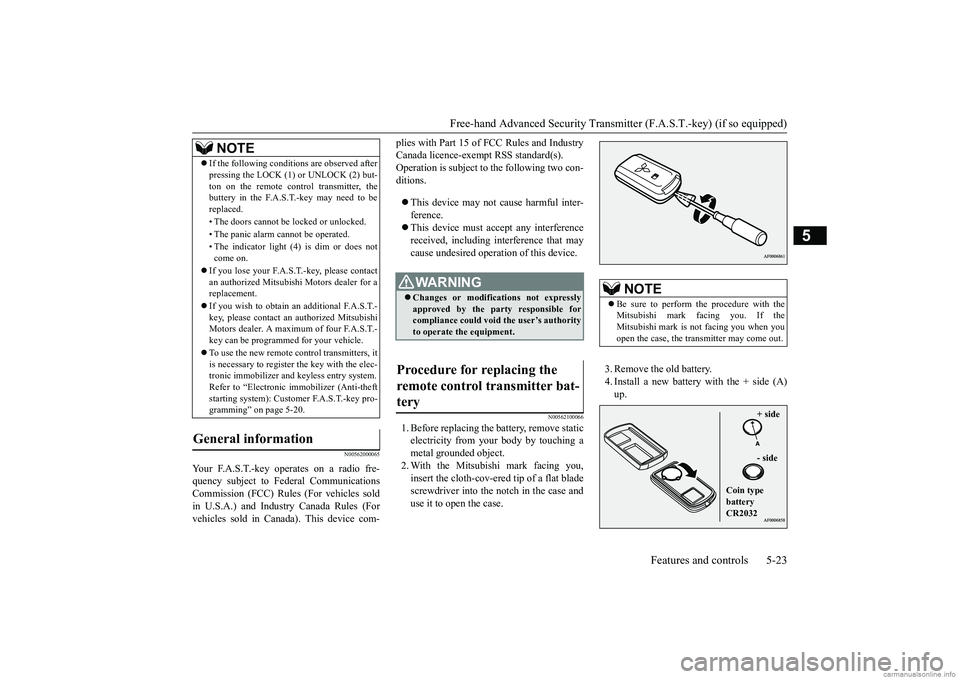
Free-hand Advanced Securi
ty Transmitter (F.A.S.T.-key) (if so equipped)
Features and controls 5-23
5
N00562000065
Your F.A.S.T.-key operates on a radio fre- quency subject to
Federal Communications
Commission (FCC) Rules
(For vehicles sold
in U.S.A.) and Industr
y Canada Rules (For
vehicles sold in Cana
da). This device com-
plies with Part 15 of FCC Rules and Industry Canada licence-exem
pt RSS standard(s).
Operation is subject to
the following two con-
ditions. This device may not
cause harmful inter-
ference. This device must ac
cept any interference
received, including interference that may cause undesired operation of this device.
N00562100066
1. Before replacing the
battery, remove static
electricity from your body by touching a metal grounded object. 2. With the Mitsubishi mark facing you,insert the cloth-cov-ered tip of a flat blade screwdriver into the notch in the case and use it to open the case.
3. Remove the old battery. 4. Install a new battery with the + side (A) up.
If the following conditions are observed after pressing the LOCK (1) or UNLOCK (2) but-ton on the remote control transmitter, thebuttery in the F.A.S.T.-key may need to be replaced. • The doors cannot be locked or unlocked. • The panic alarm
cannot be operated.
• The indicator light
(4) is dim or does not
come on.
If you lose your F.A.S.T.-key, please contact an authorized Mitsubishi Motors dealer for areplacement. If you wish to obtain an additional F.A.S.T.- key, please contact an
authorized Mitsubishi
Motors dealer. A maximum of four F.A.S.T.- key can be programmed for your vehicle. To use the new remote control transmitters, it is necessary to register the key with the elec-tronic immobilizer and
keyless entry system.
Refer to “Electronic immobilizer (Anti-theft starting system): Customer F.A.S.T.-key pro-gramming” on page 5-20.
General information
NOTE
WA R N I N G Changes or modifica
tions not expressly
approved by the party responsible for compliance could void
the user’s authority
to operate the equipment.
Procedure for replacing the remote control transmitter bat-tery
NOTE
Be sure to perform the procedure with the Mitsubishi mark facing you. If theMitsubishi mark is not facing you when you open the case, the tran
smitter may come out.
+ side - side
Coin type battery CR2032
BK0249600US.book 23 ページ 2017年4月20日 木曜日 午後1時36分
Page 90 of 263
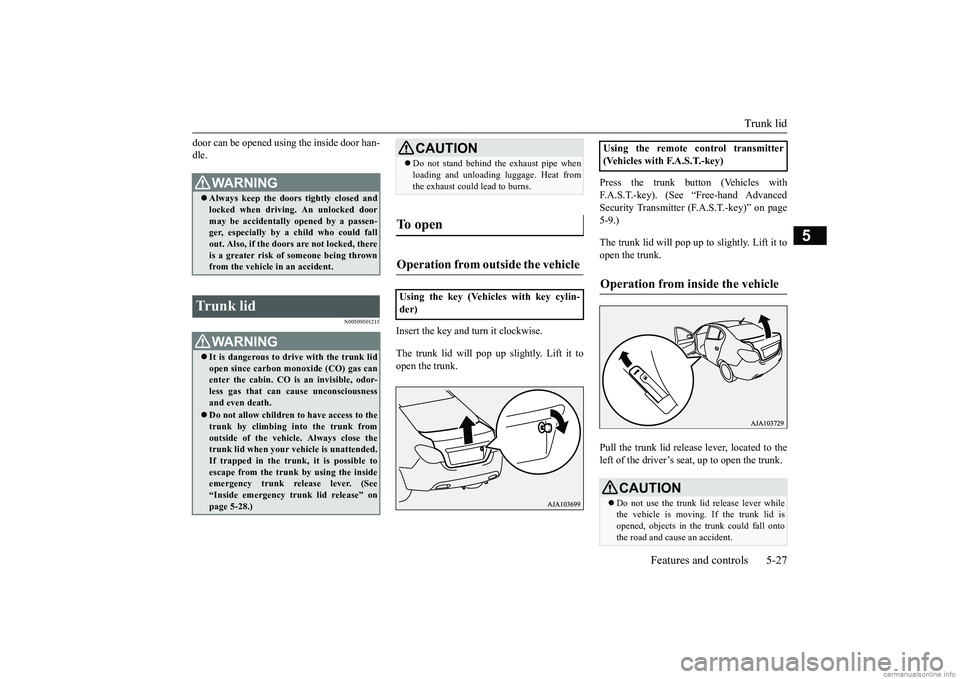
Trunk lid
Features and controls 5-27
5
door can be opened using the inside door han- dle.
N00509501215
Insert the key and turn it clockwise. The trunk lid will pop up slightly. Lift it to open the trunk.
Press the trunk button (Vehicles with F.A.S.T.-key). (See “Free-hand Advanced Security Transmitter
(F.A.S.T.-key)” on page
5-9.) The trunk lid will pop up to slightly. Lift it to open the trunk. Pull the trunk lid release
lever, located to the
left of the driver’s seat, up to open the trunk.
WA R N I N G Always keep the door
s tightly closed and
locked when driving. An unlocked door may be accidentally
opened by a passen-
ger, especially by
a child who could fall
out. Also, if the doors are not locked, there is a greater risk of
someone being thrown
from the vehicle
in an accident.
Trunk lid
WA R N I N GIt is dangerous to drive with the trunk lid open since carbon mo
noxide (CO) gas can
enter the cabin. CO is an invisible, odor- less gas that can cause unconsciousnessand even death. Do not allow children to have access to the trunk by climbing into the trunk from outside of the vehicl
e. Always close the
trunk lid when your vehicle is unattended.If trapped in the trunk, it is possible toescape from the trunk by using the inside emergency trunk re
lease lever. (See
“Inside emergency tr
unk lid release” on
page 5-28.)
CAUTION Do not stand behind the exhaust pipe when loading and unloading
luggage. Heat from
the exhaust could lead to burns.
To open Operation from outside the vehicle Using the key (Vehicles with key cylin- der)
Using the remote co
ntrol transmitter
(Vehicles with F.A.S.T.-key)Operation from inside the vehicle
CAUTION Do not use the trunk li
d release lever while
the vehicle is moving. If the trunk lid is opened, objects in the trunk could fall ontothe road and cause an accident.
BK0249600US.book 27 ページ 2017年4月20日 木曜日 午後1時36分
Page 91 of 263
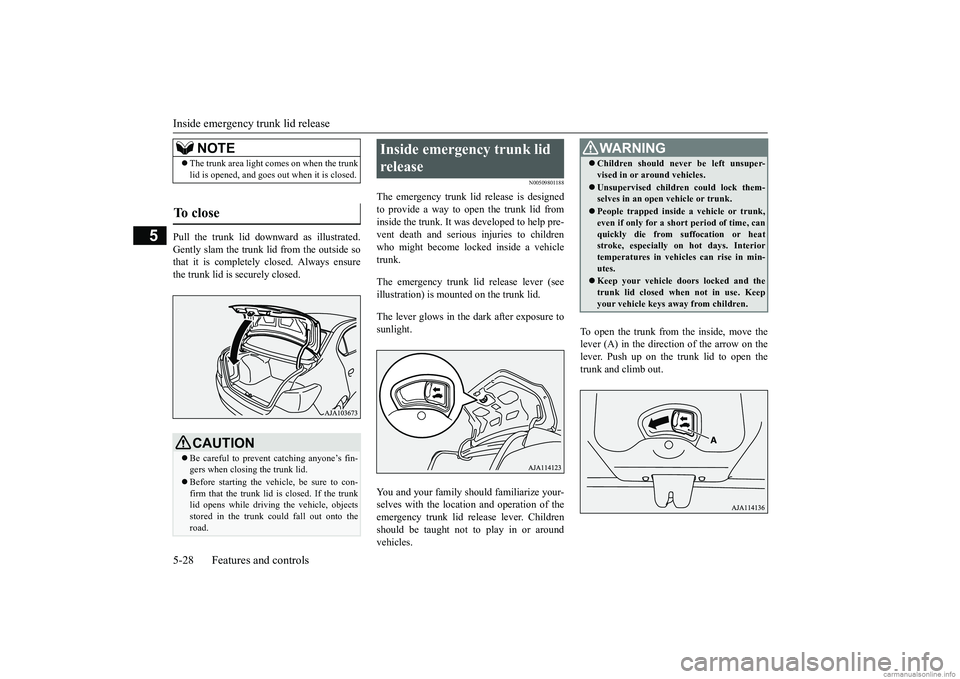
Inside emergency trunk lid release 5-28 Features and controls
5
Pull the trunk lid downward as illustrated. Gently slam the trunk lid from the outside so that it is completely closed. Always ensurethe trunk lid is securely closed.
N00509801188
The emergency trunk lid release is designed to provide a way to open the trunk lid from inside the trunk. It was developed to help pre-vent death and serious
injuries to children
who might become locked inside a vehicle trunk. The emergency trunk lid release lever (see illustration) is mounted on the trunk lid. The lever glows in the dark after exposure to sunlight. You and your family should familiarize your- selves with the location and operation of theemergency trunk lid release lever. Children should be taught not to play in or around vehicles.
To open the trunk from the inside, move the lever (A) in the direction of the arrow on thelever. Push up on the trunk lid to open the trunk and climb out.
NOTE
The trunk area light comes on when the trunk lid is opened, and goes out
when it is closed.
To close
CAUTIONBe careful to preven
t catching anyone’s fin-
gers when closing the trunk lid. Before starting the vehi
cle, be sure to con-
firm that the trunk lid is closed. If the trunk lid opens while driving the vehicle, objects stored in the trunk could fall out onto theroad.
Inside emergency trunk lid release
WA R N I N G Children should never be left unsuper- vised in or ar
ound vehicles.
Unsupervised children could lock them- selves in an open vehicle or trunk. People trapped inside a vehicle or trunk, even if only for a short period of time, can quickly die from suffocation or heatstroke, especially on
hot days. Interior
temperatures in vehicles can rise in min- utes. Keep your vehicle d
oors locked and the
trunk lid closed when not in use. Keepyour vehicle keys aw
ay from children.
BK0249600US.book 28 ページ 2017年4月20日 木曜日 午後1時36分
Page 96 of 263
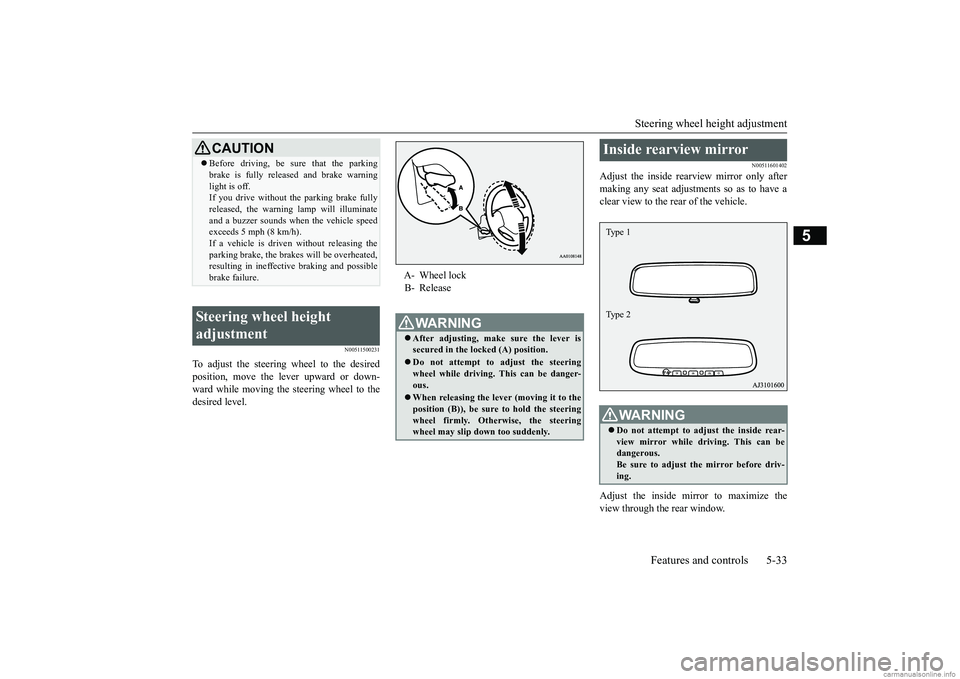
Steering wheel height adjustment
Features and controls 5-33
5
N00511500231
To adjust the steering wheel to the desired position, move the lever upward or down-ward while moving the steering wheel to the desired level.
N00511601402
Adjust the inside rearview mirror only aftermaking any seat adjustme
nts so as to have a
clear view to the rear of the vehicle. Adjust the inside mirror to maximize the view through the rear window.
CAUTION Before driving, be sure that the parking brake is fully released and brake warninglight is off.If you drive without the parking brake fully released, the warning lamp will illuminate and a buzzer sounds when the vehicle speedexceeds 5 mph (8 km/h). If a vehicle is driven without releasing the parking brake, the brakes will be overheated,resulting in ineffectiv
e braking and possible
brake failure.
Steering wheel height adjustment
A- Wheel lock B- ReleaseWA R N I N G After adjusting, make sure the lever is secured in the locked (A) position. Do not attempt to adjust the steering wheel while driving. This can be danger-ous. When releasing the leve
r (moving it to the
position (B)), be sure to hold the steering wheel firmly. Otherwise, the steering wheel may slip down too suddenly.
Inside rearview mirror
WA R N I N G Do not attempt to adjust the inside rear- view mirror while driving. This can bedangerous. Be sure to adjust the mirror before driv- ing.Type 1 Type 2
BK0249600US.book 33 ページ 2017年4月20日 木曜日 午後1時36分
Page 99 of 263
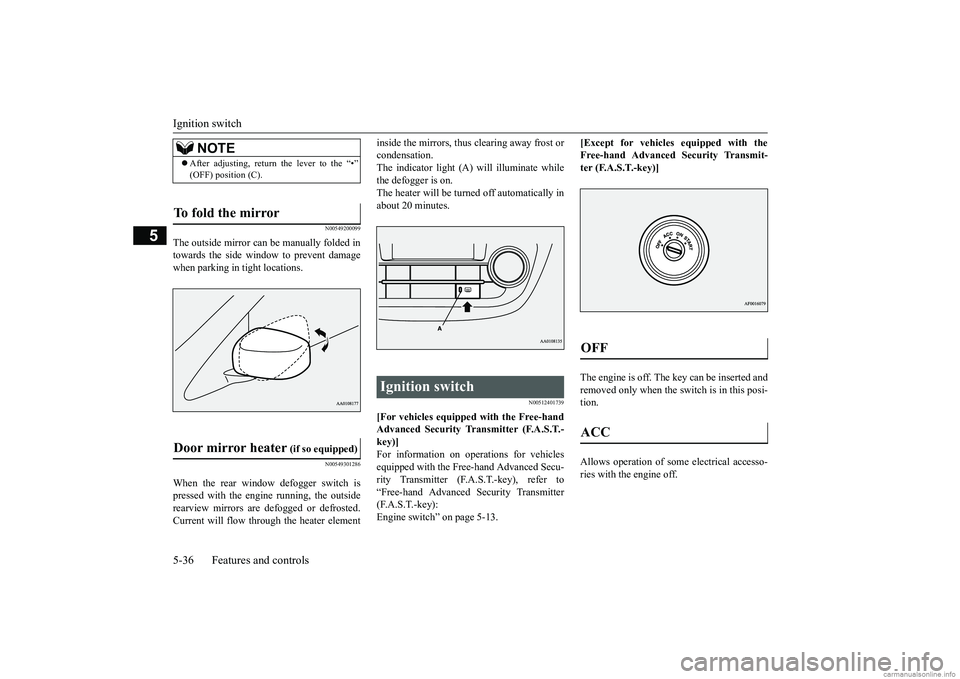
Ignition switch 5-36 Features and controls
5
N00549200099
The outside mirror can
be manually folded in
towards the side window to prevent damagewhen parking in tight locations.
N00549301286
When the rear window defogger switch ispressed with the engine running, the outside rearview mirrors are defogged or defrosted. Current will flow throug
h the heater element
inside the mirrors, thus clearing away frost or condensation.The indicator light (A) will illuminate while the defogger is on. The heater will be turned off automatically inabout 20 minutes.
N00512401739
[For vehicles equipped with the Free-handAdvanced Security Tr
ansmitter (F.A.S.T.-
key)] For information on ope
rations for vehicles
equipped with the Free-hand Advanced Secu-rity Transmitter (F.A
.S.T.-key), refer to
“Free-hand Advanced
Security Transmitter
(F.A.S.T.-key):Engine switch” on page 5-13.
[Except for vehicles equipped with the Free-hand Advanced Security Transmit-ter (F.A.S.T.-key)] The engine is off. The
key can be inserted and
removed only when the sw
itch is in this posi-
tion. Allows operation of some electrical accesso- ries with the engine off.
NOTE
After adjusting, return the lever to the “•” (OFF) position (C).
To fold the mirror Door mirror heater
(if so equipped)
Ignition switch
OFF ACC
BK0249600US.book 36 ページ 2017年4月20日 木曜日 午後1時36分
Page 100 of 263
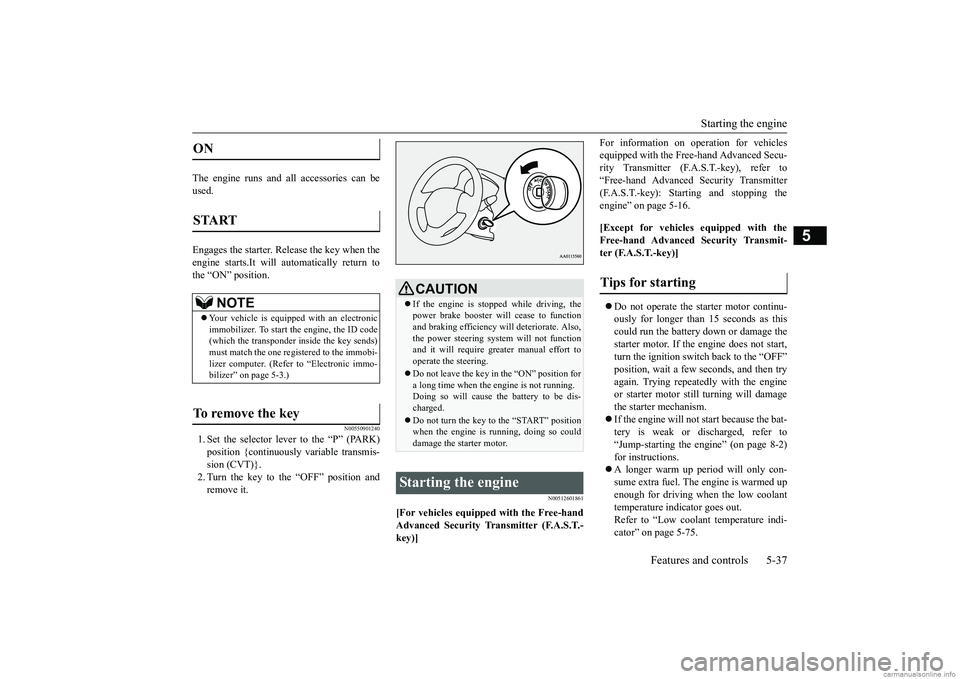
Starting the engine
Features and controls 5-37
5
The engine runs and
all accessories can be
used. Engages the starter. Release the key when the engine starts.It will automatically return to the “ON” position.
N00550901240
1. Set the selector lever to the “P” (PARK)position {continuously va
riable transmis-
sion (CVT)}. 2. Turn the key to the “OFF” position and remove it.
N00512601861
[For vehicles equipped with the Free-hand Advanced Security Transmitter (F.A.S.T.- key)]
For information on
operation for vehicles
equipped with the Free-hand Advanced Secu-rity Transmitter (F.A
.S.T.-key), refer to
“Free-hand Advanced
Security Transmitter
(F.A.S.T.-key): Starting and stopping theengine” on page 5-16. [Except for vehicles equipped with the Free-hand Advanced Security Transmit- ter (F.A.S.T.-key)] Do not operate the starter motor continu- ously for longer than 15 seconds as thiscould run the battery
down or damage the
starter motor. If the engine does not start, turn the ignition switch back to the “OFF”position, wait a few se
conds, and then try
again. Trying repeatedly with the engine or starter motor still turning will damagethe starter mechanism. If the engine will not
start because the bat-
tery is weak or discharged, refer to“Jump-starting the engine” (on page 8-2) for instructions. A longer warm up period will only con- sume extra fuel. The engine is warmed up enough for driving when the low coolant temperature indi
cator goes out.
Refer to “Low coolant temperature indi- cator” on page 5-75.
ON START
NOTE
Your vehicle is equippe
d with an electronic
immobilizer. To start
the engine, the ID code
(which the transponder inside the key sends) must match the one registered to the immobi-lizer computer. (Refer to “Electronic immo- bilizer” on page 5-3.)
To remove the key
CAUTION If the engine is stoppe
d while driving, the
power brake booster will cease to functionand braking efficiency will deteriorate. Also, the power steering syst
em will not function
and it will require gr
eater manual effort to
operate the steering. Do not leave the key in
the “ON” position for
a long time when the
engine is not running.
Doing so will cause th
e battery to be dis-
charged. Do not turn the key to the “START” position when the engine is running, doing so coulddamage the starter motor.
Starting the engine
Tips for starting
BK0249600US.book 37 ページ 2017年4月20日 木曜日 午後1時36分
Page 109 of 263
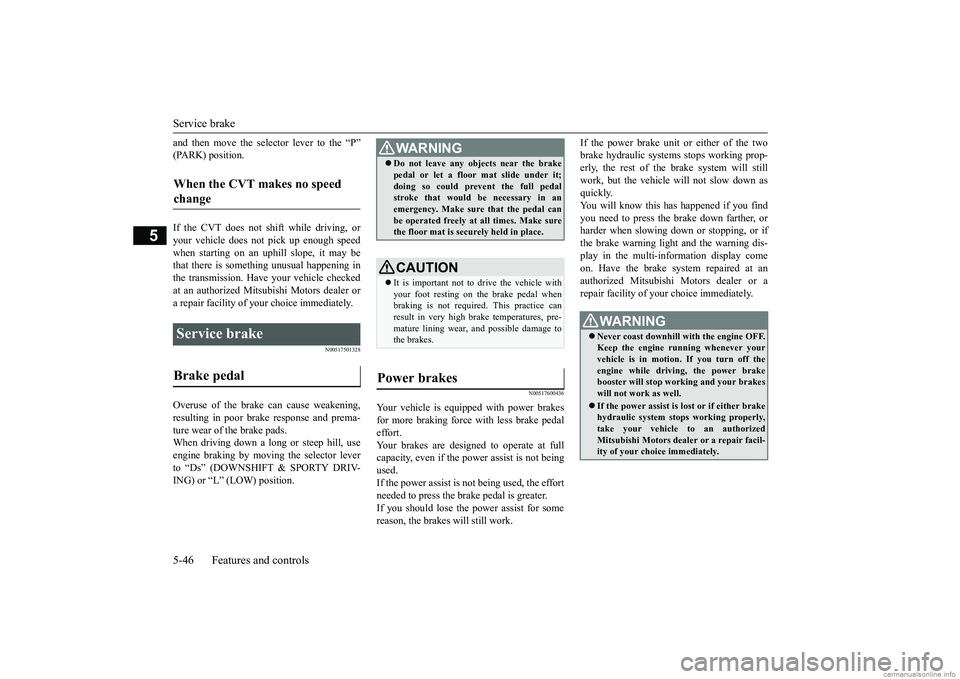
Service brake 5-46 Features and controls
5
and then move the selector lever to the “P” (PARK) position. If the CVT does not shift while driving, or your vehicle does not pick up enough speed when starting on an uphill slope, it may bethat there is something unusual happening in the transmission. Have your vehicle checked at an authorized Mitsubishi Motors dealer or a repair facility of your choice immediately.
N00517501328
Overuse of the brake can cause weakening,resulting in poor brake response and prema- ture wear of the brake pads.When driving down a long or steep hill, use engine braking by moving
the selector lever
to “Ds” (DOWNSHIFT & SPORTY DRIV-ING) or “L” (LOW) position.
N00517600436
Your vehicle is equipped with power brakesfor more braking force with less brake pedaleffort. Your brakes are designed to operate at full capacity, even if the power assist is not beingused. If the power assist is not being used, the effort needed to press the brake pedal is greater.If you should lose the power assist for some reason, the brakes will still work.
If the power brake unit or either of the two brake hydraulic systems stops working prop-erly, the rest of the brake system will still work, but the vehicle will not slow down as quickly.You will know this has happened if you find you need to press the brake down farther, or harder when slowing down or stopping, or ifthe brake warning light and the warning dis- play in the multi-information display come on. Have the brake system repaired at an authorized Mitsubishi Motors dealer or a repair facility of your choice immediately.
When the CVT makes no speed change
Service brake Brake pedal
WA R N I N G Do not leave any objects near the brake pedal or let a floor mat slide under it;doing so could prevent the full pedalstroke that would be necessary in an emergency. Make sure that the pedal can be operated freely at all times. Make surethe floor mat is securely held in place.CAUTION It is important not to
drive the vehicle with
your foot resting on the brake pedal when braking is not required. This practice canresult in very high brake temperatures, pre- mature lining wear, a
nd possible damage to
the brakes.
Power brakes
WA R N I N G Never coast downhill
with the engine OFF.
Keep the engine running whenever your vehicle is in motion.
If you turn off the
engine while driving, the power brake booster will stop wo
rking and your brakes
will not work as well. If the power assist is lost or if either brake hydraulic system stops working properly,take your vehicle to an authorized Mitsubishi Motors dealer
or a repair facil-
ity of your choice immediately.
BK0249600US.book 46 ページ 2017年4月20日 木曜日 午後1時36分
Page 125 of 263
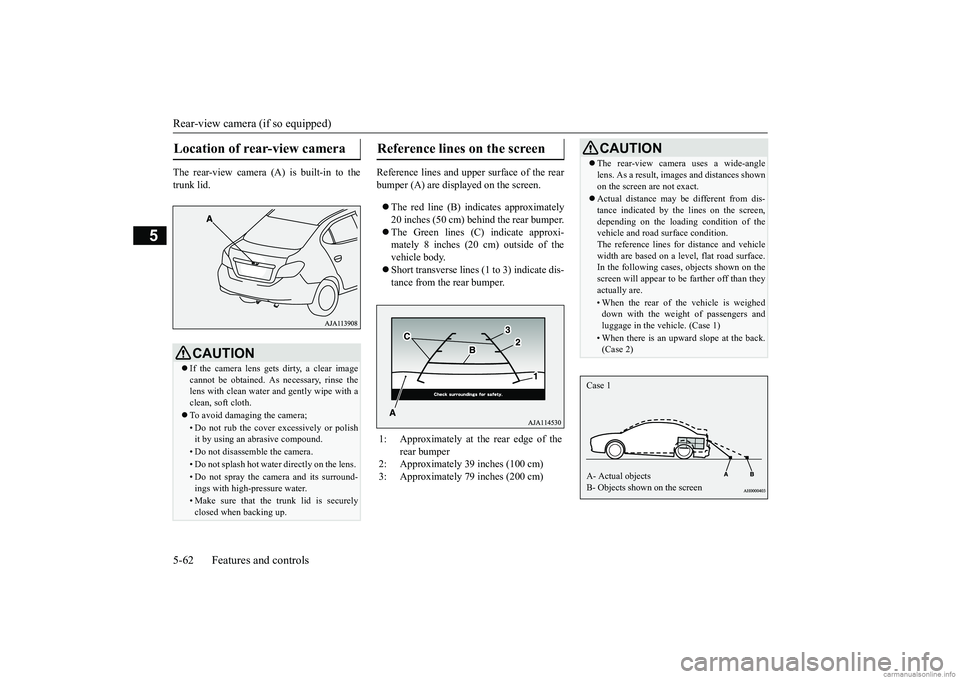
Rear-view camera (if so equipped) 5-62 Features and controls
5
The rear-view camera (A) is built-in to the trunk lid.
Reference lines and uppe
r surface of the rear
bumper (A) are displayed on the screen. The red line (B) i
ndicates approximately
20 inches (50 cm) behind the rear bumper. The Green lines (C) indicate approxi- mately 8 inches (20 cm) outside of the vehicle body. Short transverse lines (1 to 3) indicate dis- tance from the rear bumper.
Location of rear-view camera
CAUTION If the camera lens gets
dirty, a clear image
cannot be obtained. As
necessary, rinse the
lens with clean water a
nd gently wipe with a
clean, soft cloth. To avoid damaging the camera;• Do not rub the cover excessively or polish it by using an abrasive compound. • Do not disassemble the camera.• Do not splash hot wate
r directly on the lens.
• Do not spray the camera and its surround- ings with high-pressure water.• Make sure that the trunk lid is securelyclosed when backing up.
Reference lines on the screen
1: Approximately at the rear edge of the
rear bumper
2: Approximately 39 inches (100 cm) 3: Approximately 79 inches (200 cm)
CAUTION The rear-view camera uses a wide-angle lens. As a result, imag
es and distances shown
on the screen are not exact. Actual distance may be
different from dis-
tance indica
ted by the lines on the screen,
depending on the loading condition of the vehicle and road
surface condition.
The reference lines for
distance and vehicle
width are based on a leve
l, flat road surface.
In the following cases, objects shown on the screen will appear to be farther off than theyactually are.• When the rear of the vehicle is weigheddown with the weight of passengers and luggage in the ve
hicle. (Case 1)
• When there is an upward slope at the back. (Case 2)
Case 1 A- Actual objects B- Objects shown on the screen
BK0249600US.book 62 ページ 2017年4月20日 木曜日 午後1時36分